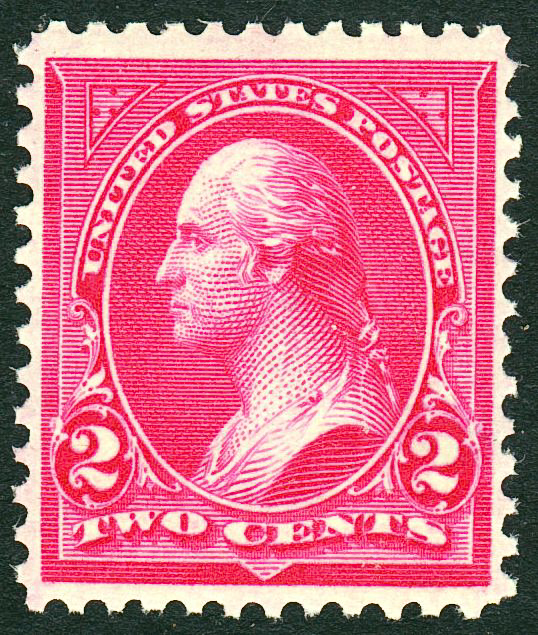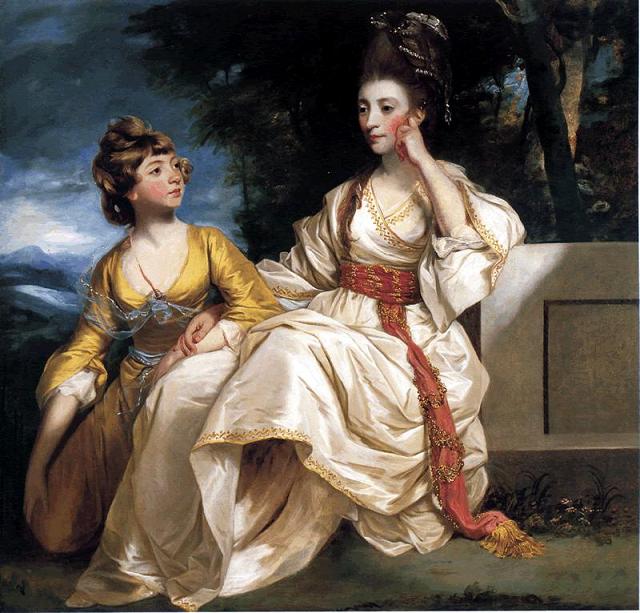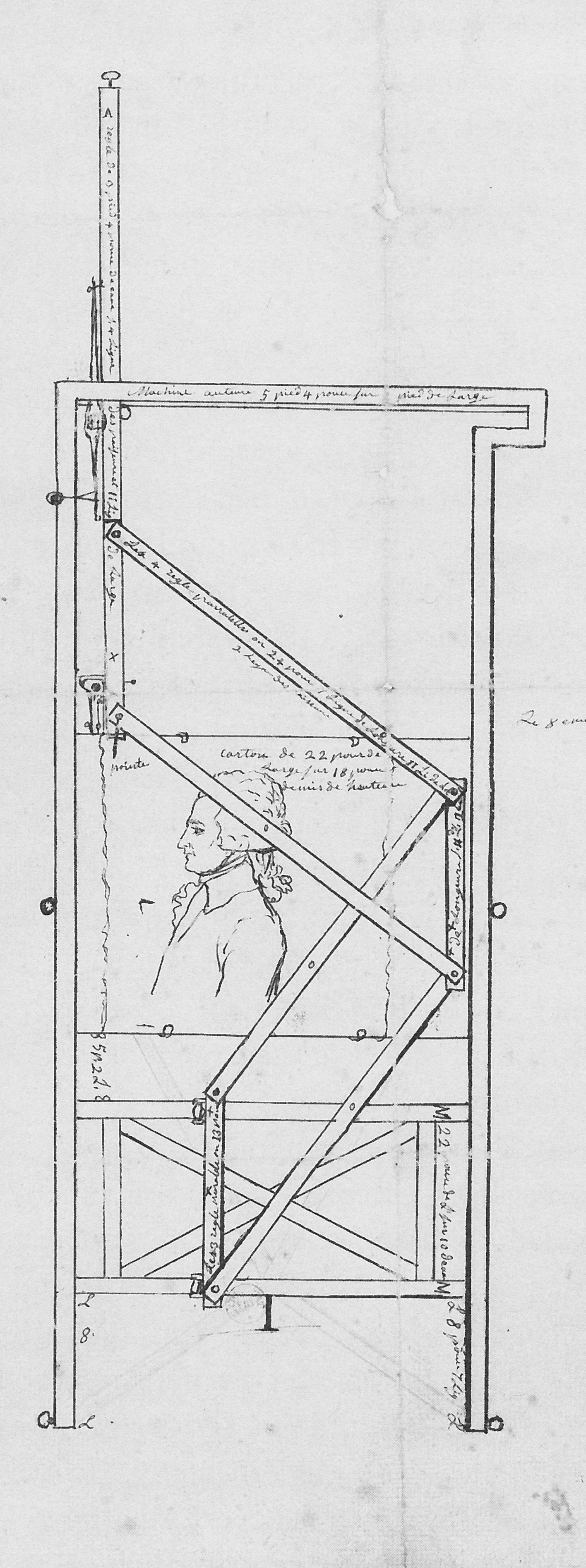|
James Sharples (portrait Painter)
James Sharples (1751 or 1752, in Lancashire – 26 February 1811, in New York City) was an English portrait painter and pastelist, who moved to the United States in 1794. He first exhibited at the Royal Academy in 1779. Biography Sharples first intended to enter the Catholic priesthood, but became an artist instead. Sharples headed a family of successful portrait artists, including his third wife Ellen Sharples. He had four children: George by his first wife; Felix Thomas Sharples from his second marriage (c. 1786- after 1823); and James Sharples Jr.(c. 1788–1839) and daughter Rolinda Sharples (1793–1838) with this third wife, Ellen. Felix, James Jr. and Rolinda joined the family enterprise at ages 17, 15, and 13 respectively. Before marrying Ellen Wallace, James had been active in Bristol, Liverpool, and Bath, where he taught drawing. The family left for the United States in 1796, but, according to Ellen's diaries, their ship fell into the hands of the French, and for ... [...More Info...] [...Related Items...] OR: [Wikipedia] [Google] [Baidu] |
Lancashire
Lancashire ( , ; abbreviated Lancs) is the name of a historic county, ceremonial county, and non-metropolitan county in North West England. The boundaries of these three areas differ significantly. The non-metropolitan county of Lancashire was created by the Local Government Act 1972. It is administered by Lancashire County Council, based in Preston, and twelve district councils. Although Lancaster is still considered the county town, Preston is the administrative centre of the non-metropolitan county. The ceremonial county has the same boundaries except that it also includes Blackpool and Blackburn with Darwen, which are unitary authorities. The historic county of Lancashire is larger and includes the cities of Manchester and Liverpool as well as the Furness and Cartmel peninsulas, but excludes Bowland area of the West Riding of Yorkshire transferred to the non-metropolitan county in 1974 History Before the county During Roman times the area was part of the Bri ... [...More Info...] [...Related Items...] OR: [Wikipedia] [Google] [Baidu] |
Bristol
Bristol () is a city, ceremonial county and unitary authority in England. Situated on the River Avon, it is bordered by the ceremonial counties of Gloucestershire to the north and Somerset to the south. Bristol is the most populous city in South West England. The wider Bristol Built-up Area is the eleventh most populous urban area in the United Kingdom. Iron Age hillforts and Roman villas were built near the confluence of the rivers Frome and Avon. Around the beginning of the 11th century, the settlement was known as (Old English: 'the place at the bridge'). Bristol received a royal charter in 1155 and was historically divided between Gloucestershire and Somerset until 1373 when it became a county corporate. From the 13th to the 18th century, Bristol was among the top three English cities, after London, in tax receipts. A major port, Bristol was a starting place for early voyages of exploration to the New World. On a ship out of Bristol in 1497, John Cabot, a Venetia ... [...More Info...] [...Related Items...] OR: [Wikipedia] [Google] [Baidu] |
Joseph Priestley
Joseph Priestley (; 24 March 1733 – 6 February 1804) was an English chemist, natural philosopher, separatist theologian, grammarian, multi-subject educator, and liberal political theorist. He published over 150 works, and conducted experiments in electricity and other areas of science. He was a close friend of, and worked in close association with Benjamin Franklin involving electricity experiments. Priestley is credited with his independent discovery of oxygen by the thermal decomposition of mercuric oxide, having isolated it in 1774. During his lifetime, Priestley's considerable scientific reputation rested on his invention of carbonated water, his writings on electricity, and his discovery of several "airs" (gases), the most famous being what Priestley dubbed "dephlogisticated air" (oxygen). Priestley's determination to defend phlogiston theory and to reject what would become the chemical revolution eventually left him isolated within the scientific community. Prie ... [...More Info...] [...Related Items...] OR: [Wikipedia] [Google] [Baidu] |
Hester Thrale
Hester Lynch Thrale Piozzi (née Salusbury; later Piozzi; 27 January 1741 or 16 January 1740 – 2 May 1821),Contemporary records, which used the Julian calendar and the Annunciation Style of enumerating years, recorded her birth as 16 January 1740. The provisions of the British Calendar (New Style) Act 1750, implemented in 1752, altered the official British dating method to the Gregorian calendar with the start of the year on 1 January (it had been 25 March). These changes resulted in dates being moved forward 11 days, and for those between 1 January and 25 March, an advance of one year. For further explanation, see: Old Style and New Style dates. a Welsh-born diarist, author and patron of the arts, is an important source on Samuel Johnson and 18th-century English life. She belonged to the prominent Salusbury family, Anglo-Welsh landowners, and married first a wealthy brewer, Henry Thrale, then a music teacher, Gabriel Mario Piozzi. Her '' Anecdotes of the Late Samuel Johnson' ... [...More Info...] [...Related Items...] OR: [Wikipedia] [Google] [Baidu] |
Thomas Jefferson
Thomas Jefferson (April 13, 1743 – July 4, 1826) was an American statesman, diplomat, lawyer, architect, philosopher, and Founding Fathers of the United States, Founding Father who served as the third president of the United States from 1801 to 1809. He was previously the nation's second vice president of the United States, vice president under John Adams and the first United States Secretary of State, United States secretary of state under George Washington. The principal author of the United States Declaration of Independence, Declaration of Independence, Jefferson was a proponent of democracy, republicanism, and individual rights, motivating Thirteen Colonies, American colonists to break from the Kingdom of Great Britain and form a new nation. He produced formative documents and decisions at state, national, and international levels. During the American Revolution, Jefferson represented Virginia in the Continental Congress that adopted the Declaration of Independence. As ... [...More Info...] [...Related Items...] OR: [Wikipedia] [Google] [Baidu] |
George Washington
George Washington (February 22, 1732, 1799) was an American military officer, statesman, and Founding Father who served as the first president of the United States from 1789 to 1797. Appointed by the Continental Congress as commander of the Continental Army, Washington led the Patriot forces to victory in the American Revolutionary War and served as the president of the Constitutional Convention of 1787, which created the Constitution of the United States and the American federal government. Washington has been called the " Father of his Country" for his manifold leadership in the formative days of the country. Washington's first public office was serving as the official surveyor of Culpeper County, Virginia, from 1749 to 1750. Subsequently, he received his first military training (as well as a command with the Virginia Regiment) during the French and Indian War. He was later elected to the Virginia House of Burgesses and was named a delegate to the Continental Congress ... [...More Info...] [...Related Items...] OR: [Wikipedia] [Google] [Baidu] |
Physiognotrace
A physiognotrace is an instrument, designed to trace a person's physiognomy to make semi-automated portrait aquatints. Invented in France in 1783–1784, it was popular for some decades. The sitter climbed into a wooden frame (1.75m high x 0.65m wide), sat and turned to the side to pose. A pantograph connected to a pencil produced within a few minutes a "grand trait", a contour line on a piece of paper. With the help of a second scaling-down pantograph, the basic features of the portrait were transferred from the sheet in the form of dotted lines to a copper plate, which had previously been prepared with a ground for etching. One week later, the sitter received an etched plate and twelve little prints. The device but also the aquatint prints are called physionotraces. History In 1783–1784, the Frenchman Gilles-Louis Chrétien invented the "physionotrace" to aid in the production of silhouette portraits, which became popular during the reign of Louis XVI. Within a few minutes, ... [...More Info...] [...Related Items...] OR: [Wikipedia] [Google] [Baidu] |
William Hull
William Hull (June 24, 1753 – November 29, 1825) was an American soldier and politician. He fought in the American Revolutionary War and was appointed as Governor of Michigan Territory (1805–13), gaining large land cessions from several American Indian tribes under the Treaty of Detroit (1807). He is most widely remembered, however, as the general in the War of 1812 who surrendered Fort Detroit to the British on August 16, 1812 following the Siege of Detroit. After the battle, he was court-martialed, convicted, and sentenced to death, but he received a pardon from President James Madison and his reputation somewhat recovered. Early life and education Hull was born in Derby, Connecticut on June 24, 1753. He graduated from Yale University in 1772, studied law in Litchfield, Connecticut, and joined the bar in 1775. Career Revolutionary War At the outbreak of fighting in the American Revolutionary War (1775-1783), Hull joined a local militia and was quickly promoted to captain, ... [...More Info...] [...Related Items...] OR: [Wikipedia] [Google] [Baidu] |
Anthony Wayne, Uniform
Anthony or Antony is a masculine given name, derived from the '' Antonii'', a ''gens'' ( Roman family name) to which Mark Antony (''Marcus Antonius'') belonged. According to Plutarch, the Antonii gens were Heracleidae, being descendants of Anton, a son of Heracles. Anthony is an English name that is in use in many countries. It has been among the top 100 most popular male baby names in the United States since the late 19th century and has been among the top 100 male baby names between 1998 and 2018 in many countries including Canada, Australia, England, Ireland and Scotland. Equivalents include ''Antonio'' in Italian, Spanish, Portuguese and Maltese; ''Αντώνιος'' in Greek; ''António'' or ''Antônio'' in Portuguese; ''Antoni'' in Catalan, Polish, and Slovene; '' Anton'' in Dutch, Galician, German, Icelandic, Romanian, Russian, and Scandinavian languages; ''Antoine'' in French; '' Antal'' in Hungarian; and ''Antun'' or '' Ante'' in Croatian. The usual abbreviated form is ... [...More Info...] [...Related Items...] OR: [Wikipedia] [Google] [Baidu] |
Portraits Of A Man And A Woman, By James Sharples
A portrait is a painting, photograph, sculpture, or other artistic representation of a person, in which the face and its expressions are predominant. The intent is to display the likeness, personality, and even the mood of the person. For this reason, in photography a portrait is generally not a snapshot, but a composed image of a person in a still position. A portrait often shows a person looking directly at the painter or photographer, in order to most successfully engage the subject with the viewer. History Prehistorical portraiture Plastered human skulls were reconstructed human skulls that were made in the ancient Levant between 9000 and 6000 BC in the Pre-Pottery Neolithic B period. They represent some of the oldest forms of art in the Middle East and demonstrate that the prehistoric population took great care in burying their ancestors below their homes. The skulls denote some of the earliest sculptural examples of portraiture in the history of art. Historical portraitur ... [...More Info...] [...Related Items...] OR: [Wikipedia] [Google] [Baidu] |
Carlos Martínez De Irujo Y Tacón
Carlos may refer to: Places ;Canada * Carlos, Alberta, a locality ;United States * Carlos, Indiana, an unincorporated community * Carlos, Maryland, a place in Allegany County * Carlos, Minnesota, a small city * Carlos, West Virginia ;Elsewhere * Carlos (crater), Montes Apenninus, LQ12, Moon; a lunar crater near Mons Hadley People * Carlos (given name), including a list of name holders * Carlos (surname), including a list of name holders Sportspeople * Carlos (Timorese footballer) (born 1986) * Carlos (footballer, born 1995), Brazilian footballer * Carlos (footballer, born 1985), Brazilian footballer Others * Carlos (Calusa) (died 1567), king or paramount chief of the Calusa people of Southwest Florida * Carlos (DJ) (born 1966), British DJ * Carlos (singer) (1943—2008), French entertainer * Carlos the Jackal, a Venezuelan terrorist *Carlos (DJ) (born 2010) Guyanese DJ Arts and entertainment * ''Carlos'' (miniseries), 2010 biopic about the terrorist Carlos the Jackal * '' ... [...More Info...] [...Related Items...] OR: [Wikipedia] [Google] [Baidu] |
Bristol Archives
Bristol Archives (formerly Bristol Record Office) was established in 1924. It was the first borough record office in the United Kingdom, since at that time there was only one other local authority record office (Bedfordshire) in existence. It looks after the official archives of the City of Bristol, besides collecting and preserving many other records relating to the city and surrounding area for current and future generations to consult. It moved from the City Hall to newly converted premises in the former B Bond Warehouse in 1992. The office is formally recognised by the Lord Chancellor for holding public records, and it acts as a diocesan record office for the Diocese of Bristol. Major deposited collections include those of J. S. Fry & Sons, chocolate manufacturers, 1693–1966, and Imperial Brands (formerly W.D. & H.O. Wills, tobacco manufacturers), late 18th century – 20th century. However, for many years one of its best-known holdings was a single volume of judicial ... [...More Info...] [...Related Items...] OR: [Wikipedia] [Google] [Baidu] |







